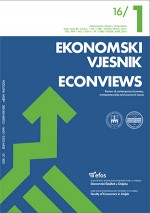MODELING EXCHANGE RATE VOLATILITIES IN CROATIA
MODELING EXCHANGE RATE VOLATILITIES IN CROATIA
Author(s): Mile Bošnjak, Vlatka Bilas, Ivan NovakSubject(s): National Economy, Financial Markets, Accounting - Business Administration
Published by: Sveučilište Josipa Jurja Strossmayera u Osijeku, Ekonomski fakultet u Osijeku
Keywords: GARCH model; heteroscedasticity; exchange rate volatility; Croatia;
Summary/Abstract: Modeling and forecasting exchange rate volatility has important implications in a range of areas in macroeconomics and finance. A number of models have been developed in empirical finance literature to investigate this volatility across different regions and countries. Well known and frequently applied models to estimate exchange rate volatility are the autoregressive conditional heteroscedastic (ARCH) model advanced by Engle (1982) and the generalized (GARCH) model developed independently by Bollerslev (1986) and Taylor (1986). This paper examines the performance of several ARCH models for the EUR and USD against the HRK on daily data sets within the time period from 1997 to 2015. Evaluating the models through standard information criteria showed that the GARCH (2,1) is the best fitted model for the EUR/HRK and the GARCH (1,1) for the USD/HRK daily return volatility. In accordance to the estimated models there is no empirical evidence that negative and positive shocks imply a different next period volatility of the daily EUR/HRK as well as the USD/HRK exchange rate return.
- Issue Year: 29/2016
- Issue No: 1
- Page Range: 81-94
- Page Count: 14
- Language: English

